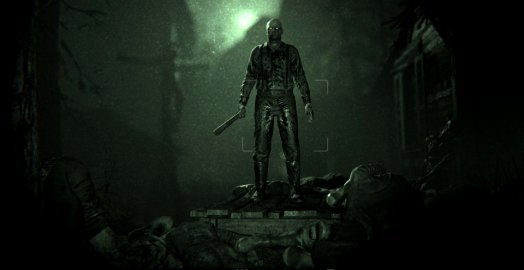Review for Outlast 2

Sneak. Run. Hide. Outlast 2 adamantly follows the formula of its predecessor, a first-person, found footage-style horror game. Equipped with a video camera and night vision, players are powerless against the threats lurking the dark. With a few improvements that end up buried beneath frustrating A.I. and an all-too-familiar story of religious cults, coupled with a parallel narrative of guilt and psychological horror that lacks genuine surprises, this sequel often feels like developer Red Barrels are just spinning their wheels rather than driving this franchise to new and interesting places.
Outlast 2 does not pick up the story of the debut installment, which may disappoint those looking for a continuation of that game’s open ending, but personally I think this approach could give the franchise more longevity. This time the tale centers on cameraman Blake Langermann and his journalist wife Lynn, who are investigating circumstances behind the murder of a Jane Doe when their helicopter is struck from the sky by an inexplicable flash of light. After coming to, his wife missing and the pilot reduced to a corpse strung up in a ritualistic fashion, Blake plunges into the abominable night with nothing but a video camera in hand. In his struggle to rescue Lynn, not only is he assailed by religious cultists, he also suffers hallucinatory nightmares of the time he and his wife both spent in a Catholic school as children. The gameplay transition between these narratives is silky smooth, but their connection is very thin, almost fighting each other for dominance.
To my surprise, the game supposedly takes place in central Arizona – the same region I happen to call home. Which means I feel obligated to draw attention to the fact that the Montreal-based developers seem to have confused the mountainous, forested terrain of northern Arizona with the sprawling cities and flat deserts that make up the state’s central region. I admit this is entirely incidental, as the high desert with its red sand, cacti, trees, lakes and caverns makes for a wonderfully idyllic setting that contrasts with the rundown asylum of the original Outlast. The real negative here is that it seldom reaches the same oppressive and claustrophobic tension this time around. Don’t be fooled by the open air, though, as the level design is just as linear. The extra space is largely an illusion, and the only reason you’ll ever feel lost is due to the wooden homes and rocky paths giving you a sense of “have I been here before?”
Visually Outlast 2 is quite pleasing, making fine use of Unreal Engine 3 (which was a decade old upon this game’s release). Texture detail is strikingly realistic most of the time and the lighting effects create a thoroughly spooky atmosphere. Since you will be viewing the majority of the action through the lens of a video camera, it’s nice to see the developers toned down the film grain effect for the sequel so you can better appreciate the detail put into the environments and the disgusting amounts of gore everywhere. Take this as a warning if you’re weak of stomach: there are an uncountable number of corpses (including a pit of dead babies) and gallons of blood (complete with an homage to Kubrick’s adaptation of The Shining).
Besides the naturalistic desert and overly similar hovels you’ll meander through, you will also explore the hallways and classrooms unfurling from Blake’s mind. Prepare for wanton and copious – boo! – jump scares throughout. That’s par for the course for this series, it seems; if only the frights had some originality. Shadowy figures run by and animals leap out, accompanied by musical stings that are overly loud to catch you off guard, while locker doors bang about from some invisible force. And at least once you’ll turn around to find a threatening foe ready to attack. Yet despite the lack of creativity in this regard, the atmosphere in Outlast 2 is potent, and the locales are a suitably dark representation of humanity’s ugliness corrupting the beauty of nature and the innocence of youth.
Slow, moody sections give way to levels infested with murderous zealots (and one nightmare monster). Typically you are made aware of any enemy presence and can take advantage of their predictable patrol routes to sneak by undetected. If spotted, however, your only option is to run and hide in tall grass, under beds, or inside barrels. You can also deadbolt doors to slow enemies down or block entrances with furniture to prevent them from reaching you at all – but only if there is already something like a cabinet conveniently placed beside the door.
In some cases, instead of hiding you could just keep running until your stalkers can’t chase anymore (i.e. when you reach a new location). That is, unless you hit a puzzle. Well, “puzzle” is a generous term here. The most elaborate obstacles involve pushing a box to give you the necessary height to reach an exit, finding a switch to shut off an environmental hazard, or hunting down a key. To be fair, I don’t think Outlast 2 needs more complex objectives, since the point of them is merely to keep you in harm’s way just a little longer. But I wouldn’t complain about being given a more creative task than box pushing.
The most gripping parts of the gameplay are the scripted chase sequences. The anxiety of having enemies right on your tail as you vault over objects, crawl through tight spaces, lock doors behind you, and quickly identify an exit as you enter a room is pretty exhilarating. Having a button to look over your shoulder to see how close your pursuers are makes it all the more heart-pounding. There’s a small amount of platforming required, such as jumping over gaps and sidling ledges. You can now even hang from ledges to elude enemies, if for instance you are on a balcony. This also allows you to shorten the distance you'll drop to lessen the potential impact damage of the landing, but overall hanging almost never factors in. One new feature that does get a good amount of play is water. When deep enough you can submerge yourself to avoid detection much the same way you might utilize other hiding spots, with the caveat that you can only hold your breath for so long, of course.
The cat-and-mouse game is improved by the newly featured directional microphone on your video camera. Activating this amplifies sounds emanating from wherever you point, even through walls, whether it’s footsteps or psychotic muttering. Gratefully, the microphone doesn’t drain your battery level on its own (at least, not after a patch that addressed this headache), but you still have to deal with some of the least effective batteries ever made when night vision is active. I can forgive this because batteries are plentiful on the Normal difficulty setting – a tradeoff that’s likely meant to enforce the gameplay loop of scouring the environment and putting the player in further danger.
Besides some precarious cliffs, pits and hazardous exposed wires, it’s primarily the encounters with hostiles that emphasize how truly defenseless Blake is. You can take a few strikes from standard enemies before you need to tend your wounds, but no matter how much you want to pick up that pitchfork or machete you have no weapons of your own. Along with collecting batteries, you will have to stock up on bandages you find to restore you back to full health. Without a clear health meter, you must rely on screen effects and the obvious change in Blake’s gait to determine his condition. The same is true of stamina, which you now need to account for, unlike in the original game where you could run endlessly. Blake will breathe heavily as he tires, eventually hobbling weakly, increasing the pressure when you’re being chased because the last thing you can afford to do is slow down or stop to let him catch his breath.
One unique section has you steer a raft through some rapids, which serves as a nice change of pace. However, it’s really just an amusement park ride since the raft won’t take damage from crashing into rocks, unless the story dictates otherwise. Similarly, there are some Quick Time Events sporadically placed throughout the game. I know this is a sore spot for some players, but if it’s any consolation they aren’t particularly invasive, nor are they difficult to overcome.
One of the greatest feats of Outlast 2 is its sense of immersion. No load screens except its initial startup and reloading after game-overs. No HUD either, as the batteries and bandages you pick up are visibly displayed in the open pockets of your jacket so you can always see how much you’re holding just by looking down. There you'll see the camera as well, where you can parse through the footage you’ve captured. All video recordings are in chronological order and empty spaces indicate any you've missed along the way, thus giving you a good idea of where to look in your next playthrough, if you so choose. You’ll know when you’ve found a point of filming interest since a circular meter begins to fill when focused on it, so don’t ever put your camera away. (I don’t rightly know why you even can.) One minor annoyance is that Blake offers commentary on everything you record but in order to hear it you have to play back what you just filmed. Ideally, he should comment as you’re capturing the initial footage instead of making you sit in awkward silence until the meter is full. After all, the vast majority of your recordings are in locations devoid of threat.
A few encounters nearly break the experience. You see, special enemies (the ones with names and story significance) don’t always play by the rules the game has established. For example, at one point I was trying to push a cart into position to clamor up a wall when the pickaxe-wielding, robe-shrouded Marta confronted me, and in the ensuing pursuit she miraculously busted through a fence with such speed and distance traveled it could only be attributed to teleportation. On top of this, I dealt with some truly frustrating A.I. tracking. Another boss-like enemy hunts you in a circular arena of trees and a few cabins you can duck into. He cannot enter the buildings but shoots arrows through the windows if he spots you. There is only a single path out of this grove and despite the boss being unaware of my position behind a log, I watched him turn back and forth to home in on whichever direction I tried to approach the exit. Since he stood completely in my path and refused to move, I had to deliberately take damage in order to pass him.
Sure, I made it through moments like these and kept trekking along, but my enjoyment and how I played going forward was harshly impacted. I began exercising less caution and tried to get through new areas as quickly as possible, since the stealthy route is a waste of effort in some cases where the A.I. is cheating you. On the plus side, any documents and recordings you acquire are retained even after a game-over and checkpoints are forgiving, although retrying a segment multiple times because the game is being unreasonable robs much of the tension. At least such frustrations are few overall, else I might've had cause to tear out my hair.
Despite all that, if you’re daring enough to attempt the Nightmare difficulty, know that enemies hit much harder (some kill you in one hit) and are more relentless, you can only carry two batteries (instead of ten on the easier difficulty), they drain a lot faster, and you find far fewer resources laying around. If you manage to complete this mode you unlock an even more challenging option aptly named Insane, where, on top of everything already mentioned, a game-over means you must start again entirely from scratch. Story Mode is the inverse of this and makes the overall experience more manageable for a wide range of players while evidently reducing the number of enemy encounters. And if you want to jump into a specific chapter after completing the game, you can do that too.
Outlast 2 has a strong conclusion, but nothing substantial happens leading up to it. You learn early on where the story is heading and essentially wait for it to be fulfilled without any twists along the way. If one thing could have redeemed this letdown, it would have been the characterization of the villains, but unlike in the original Outlast, in this game they have no personality to speak of. They simply ramble about beliefs and scripture and feel indistinguishable from one another apart from motives, despite some solid voice acting all around. Indeed the audio in general really comes through, picking up the slack when the story struggles to make players distressed. Returning composer Samuel Laflamme has created an even more impactful score this time around, full of orchestral intensity and eerie ambience.
The original Outlast and its DLC, The Whistleblower, were distilled horror experiences with their own share of issues, but here these problems are amplified. The predator-and-prey formula is already becoming stale and the jump scares are no more than haunted house thrills. Add to that an underwhelming story and unfair difficulty spikes and it becomes harder to spot the good. And there is good here. Specifically, the commitment to dark, disturbing imagery, unsettling sound design, and unbroken immersion places the game above many competing horror titles. It just often feels like Red Barrels are adhering to expectations or playing it safe – and horror should never be safe. As a sequel to a respected thriller, Outlast 2 is similar enough for returning fans to recall past joys and frights, but it introduces so few new ideas that work that it’s bound to disappoint.





























